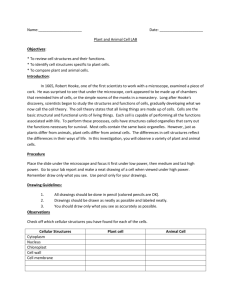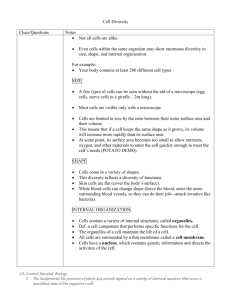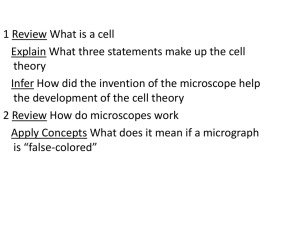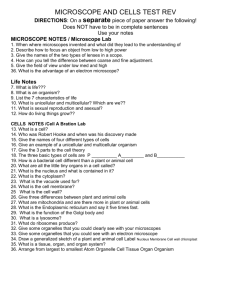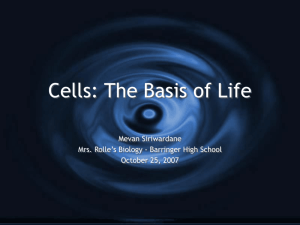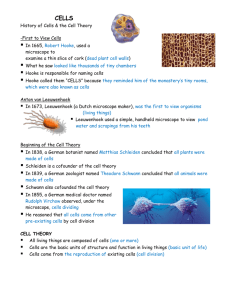History of the Cell
advertisement
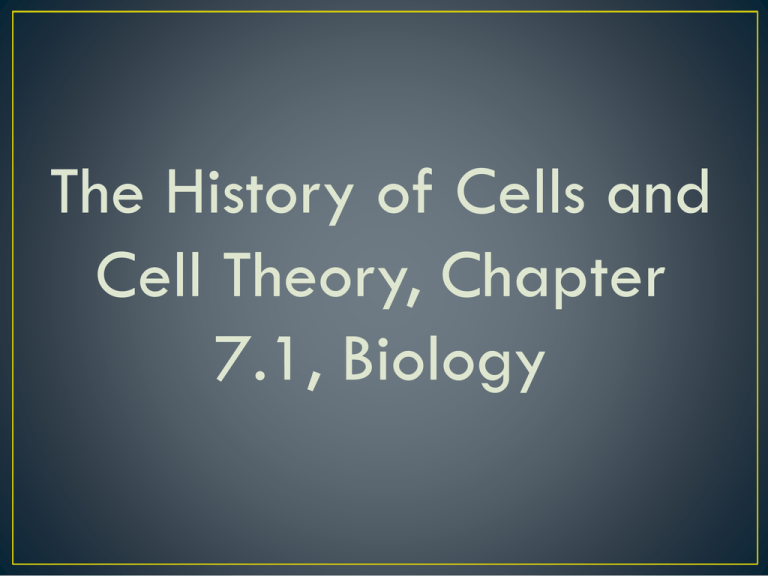
The History of Cells and Cell Theory, Chapter 7.1, Biology ● ● ● Around the year 1590, two Dutch lens makers by the name of Hans and Zacharias Janssen invented the first compound microscope when they put two of their lenses together in a tube. In 1665, an English scientist, Robert Hooke discovered and came up with the name “cells” while looking through a microscope at a piece of cork. Supposedly, the cork (which was made of dead oak tree tissues) reminded him of the small rooms that the monks lived in at the monasteries. ● Zacharias Jansen ● Robert Hooke ● Hooke's cells ● ● ● Not long after Hooke (around 1683), a Dutch amateur scientist by the name of Anton Van Leeuwenhoek observed some of the first living cells under a simple (1 lens) microscope. He named these small organisms “animalcules”. It is now believed that some of the living cells he saw were actually protozoa. ● ● In 1838 and 1839, a German botanist by the name of Matthias Schleiden and German zoologist by the name of Theodore Schwann viewed plants and animals under a microscope and discovered that plants and animals are both made of cells. In 1855 a Prussian (modern day German) physician by the name of Rudolph Virchow collaborated his ideas with the other two scientists and they developed the Cell Theory. ● The ideas of these three men led to the creation of the cell theory. These are the three main principles of cell theory. ● 1. All living organisms are made up of cells. ● 2. Cells are the most basic unit of life. ● 3. Cells only come from the division of pre-existing cells. In other words, spontaneous generation of cells does not occur. ● ● ● The discovery of cells would not have been possible without the invention of the microscope. Compound light microscopes use glass lenses just like the early microscopes Robert Hooke used. Modern compound light microscopes use electricity, a source of light, and can magnify images up to 1000x w/out blurring. ● ● Modern microscopes like the transmission electron microscope (TEM) and the scanning electron microscope (SEM) can magnify specimens up to 500,000x. One disadvantage to using these microscopes is that the specimens must be dead. ● ● ● Cells come in a variety of shapes and sizes, but all cells share some basic characteristics. One thing that all cells have in common is a plasma (cell) membrane. The cell membrane is a boundary which allows things into and out of the cell. ● ● ● ● ● All cells fall into one of two categories. Eukaryotes – Cells with a membrane-bound nucleus and membrane-bound organelles. Prokaryotes – Cells without a membrane-bound nucleus and membrane-bound organelles. A nucleus is the central organelle of a cell that contains the genetic material (DNA). Organelles are like organs for the cell. They are special structures that perform vital functions necessary to the cell. ● Prokaryotic cell – Unicellular organisms like bacteria. Notice the DNA is not found in a nucleus and organelles are absent (except ribosomes). ● Eukaryotic cells have a membrane-bound nucleus and membrane-bound organelles. Animals, plants, protists (like paramecium and amoeba), and fungi are all eukaryotic organisms.
